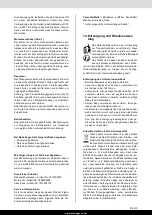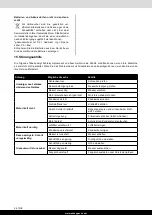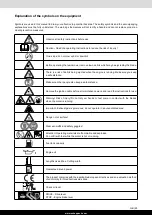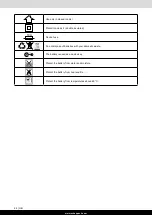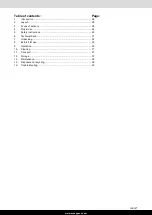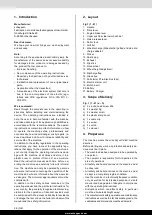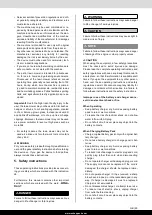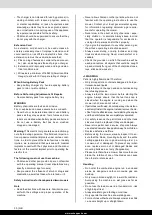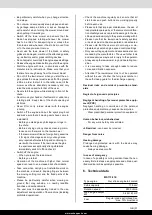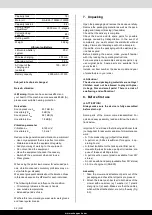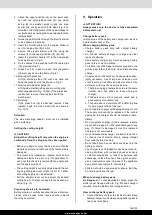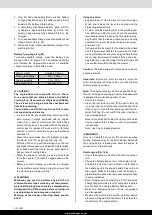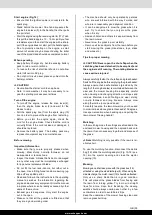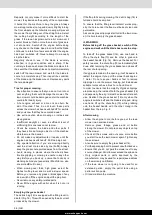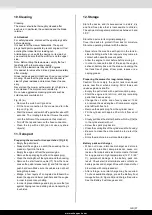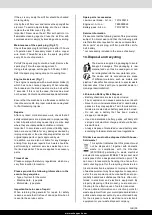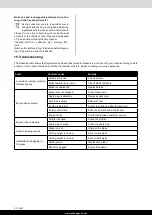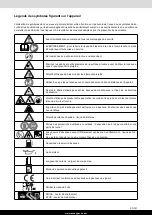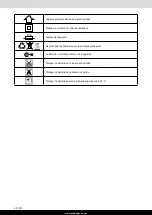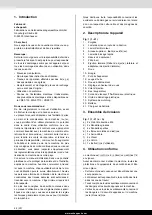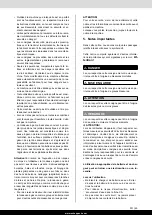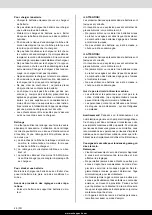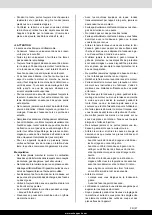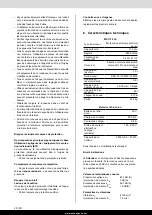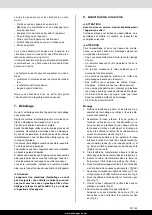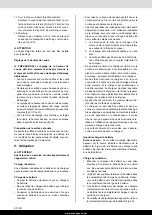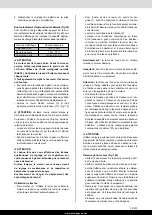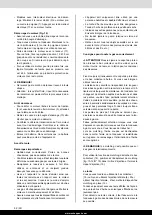
www.scheppach.com
GB | 37
12. Storage
Store the device and its accessories in a dark, dry
and frost-free place that is inaccessible to children.
The optimum storage temperature lies between 5 and
30 ˚C.
Store the device in its original packaging.
Cover the device to protect it from dust or moisture.
Store the operating manual with the device.
• Never store the machine with petrol in the tank in-
side a building in which fuel vapours may come into
contact with naked flames or sparks
• Allow the engine to cool before before storing it.
•
In order to reduce the risk of fire, keep the engine,
exhaust, battery box and the area surrounding the
fuel tank free of grass, straw, moss, leaves or es-
caping grease.
Preparing the mower for long-term storage
Caution: Do not empty the petrol tank in enclosed
areas, near fire or when smoking. Petrol fumes can
cause explosions and fire.
• Empty the petrol tank with a petrol suction pump.
• Start the engine and let it run until any remaining
petrol has been used up.
• Change the oil at the end of every season. To do
so, remove the used engine oil from a warm engine
and refill with fresh oil.
• Remove the spark plug from the cylinder head.
• Fill the cylinder with approx. 20ml of oil from an oil
can.
• Slowly pull back the starter handle, which will bathe
in the cylinder wall with oil.
• Screw the spark plug back in.
•
Clean the cooling fins of the cylinder and the housing.
• Be sure to clean the entire machine to protect the
paint.
• Store the machine in a well-ventilated place.
Battery pack and charger
• When not in use, disconnect charger and store in
a cool, dry area. Wet, damp areas can cause cor-
rosion of terminals and electrical contacts. If stored
for long periods in high temperatures (120° F / 49°
C), permanent damage to the battery pack can
result. Check electrical terminals and contacts on
battery packs and charger. Wipe with clean cloth or
blow clean with compressed air.
• After storage, a normal charge may be required.
To check available charge, press the Battery Fuel
Gauge button (E, Figure 24) and charge if required.
See the Battery Fuel Gauge section.
10. Cleaning
Cleaning
The mower should be thoroughly cleaned after
each use. In particular, the underside and the blade
retainer.
m
Attention!
For safety reasons, disconnect the spark plug cable
before cleaning.
It is best to tilt the mower backwards. The spark
plug should point upwards to prevent engine oil from
entering the intake tract or leaking out.
Alternatively, you can tilt the device on its side, but
you must make sure that the air filter is on the upper
side.
Note: Before tilting the lawnmower, empty the fuel
tank fully with a fuel scavenge pump.
Do not tilt the lawnmower beyond 90 degrees.
It is easiest to remove the dirt and grass immediately
after mowing.
Grass residues and dirt that have dried on can impair
mowing. Check that the grass ejection channel is
clear of grass residues and remove these if neces-
sary.
Never clean the mower with a water jet or high pres-
sure cleaner. The motor should remain dry.
Do not use aggressive cleaning products such as
cold cleaners or white spirit.
Fig. 24 (w)
• Remove the mulch unit / gras box.
• Fit the hose connection to the mower and turn the
tap on. (Fig. 24)
•
Start the mower and switch off again after about 30
seconds. The rotating blade bar throws the water
onto the bottom of the mower and thus cleans it.
•
Turn off the tap and remove the hose connection .
• Clean the top with a cloth (do not use any sharp
objects).
11. Transport
Preparing the mower for transportation (Fig. 22)
• Empty the petrol tank.
• Always let the engine run until it has used up the re-
mainder of petrol in the tank.
• Empty the engine oil from the warm engine.
• Remove the spark plug boot from the spark plug.
•
Clean the cooling fins of the cylinder and the housing.
• Remove the start tension cable (17) from the hook.
Loosen the quick-release lever (5) and fold the upper
push bar down. Make sure the cables are not bent
during this process.
• Wedge a few layers of corrugated cardboard be-
tween the upper and lower push bars and the engine
in order to prevent any chafing.
• In order to prevent damage and injury, secure the tool
against tipping over and sliding when transporting it
in vehicles.
Summary of Contents for 5911247905
Page 2: ...www scheppach com 2 ...
Page 4: ...www scheppach com 4 5a 5c 5 5b 5d 2 3 f 4 d a c a c d 5 b 4a d c 4 5 18 18 4 ...
Page 5: ...www scheppach com 5 12 11 kein Bild vorhanden 8 7 9 10 6 17 17 e 16 19 15 13 ...
Page 6: ...www scheppach com 6 14 15 14a 15a 17 19 max min 16 18 1 3 17 1 3 17a ...
Page 7: ...www scheppach com 7 21 21 23 10 10 24 W 25 E D 20 22 26 22 27 KLICK KLICK 22 22 21 20 20 ...
Page 108: ...www scheppach com 108 A ...
Page 109: ...www scheppach com 109 B ...

